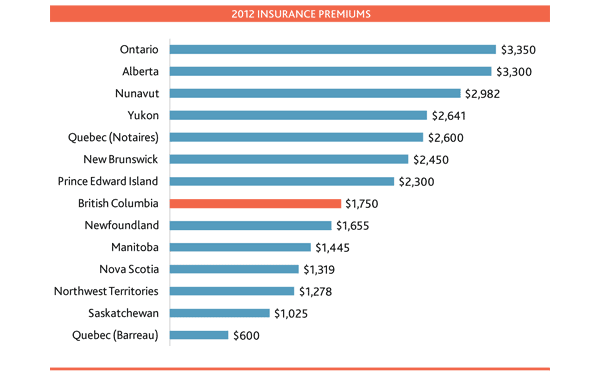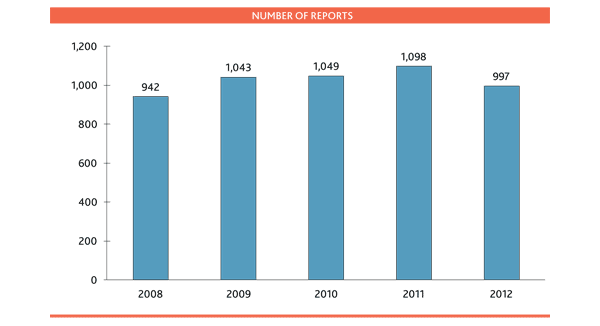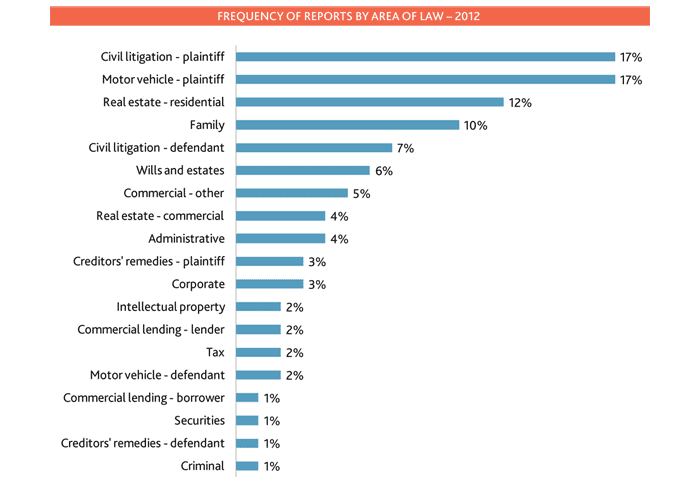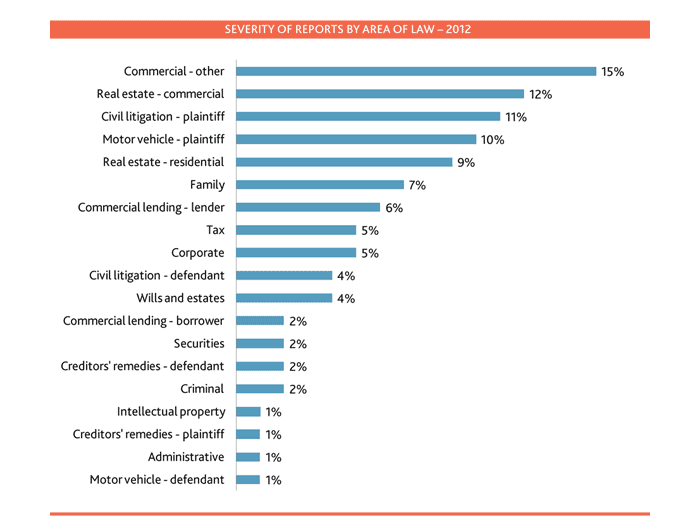This Insurance Issues:
- reports on the 2013 insurance program and policy revisions
- clarifies the application of Exclusion 6 – the “business and benefit” exclusion – to trusts
- reviews statistics on claims and potential claims
- reports on an upcoming resource – “My Insurance Policy: Questions and answers”
The Lawyers Insurance Fund manages the Law Society’s insurance program for BC lawyers. The program provides professional liability insurance for negligence (Part A), trust protection coverage for dishonest appropriation (Part B) and, since January 1, 2012, trust shortage liability insurance for reliance on fraudulent certified cheques (Part C).
Insurance assessment
The insurance fee remains at $1,750 for 2013. In 2009 and 2010, the recession triggered modest increases in the fee for the first time in 17 years. However, there have been no increases since and, through effective claims and risk management and solid investment policies, we have managed to hold the fee unchanged for a third consecutive year. Financial instability in international markets, rising costs and future claims experience may necessitate an increase in the future.
The upward trend in fees in the insurance programs in other Canadian jurisdictions continues. In fact, lawyers in nine other jurisdictions saw an insurance fee increase in 2012, while we held the line (see chart on page 2). Our policy is also unique in providing insurance for theft under Part B, as well as negligence. As in all previous years since Part B’s introduction, there will be no separate assessment levied for 2013. The Law Society continues to manage the profession’s commitment to protect innocent victims of lawyer theft at no additional cost to lawyers.

Compulsory policy wording
For 2013, the consolidated policy issued in 2012 is renewed by endorsement. The 2013 endorsement was included with the December 2012 Member’s Manual amendment package. Other policies and endorsements issued since 2000 are available on the Law Society’s website.
This year brings only a few minor changes to the policy wording. We also report on clarification of an issue that relates to Exclusion 6, the “business and benefit” exclusion.
GENERAL
Amendments to the Insurance Act in 2012 included a requirement that an insurance policy contain an explicit statement. The s.11(1)(j) statement warns that an action against the insurer for recovery of insurance money is barred unless commenced within the time set out in the Act. That statement is added at the end of the Declarations.
Since July, 2003, in accordance with the National Mobility Agreement, if the closest and most real connection to a claim arising out of a lawyer’s temporary practice is with a reciprocating jurisdiction, the BC policy provides at least the same scope of coverage as that of the reciprocating law society. A minor revision to the definition of “reciprocal jurisdiction” was required so that this expanded coverage was provided only in relation to those jurisdictions that participate in temporary mobility (none of the territories).
The Law Society has a protocol that maintains the confidentiality of claims information and sets out some exceptions, such as the Society’s financial auditors. To comply more clearly with the requirements of the Freedom of Information and Privacy Act, Condition 5.4’s reference to the protocol is amended to specifically reference the lawyer’s consent to any permitted disclosure.
Clarification of the application of Exclusion 6 – the “business and benefit” exclusion – to trusts
Exclusion 6 excludes coverage for claims in which there is a certain personal or business connection between you, your colleagues or your family and the professional services giving rise to the claim. Exclusion 6.1 – the benefit exclusion – is triggered if payment of the claim personally benefits you, your family or your law firm. Exclusion 6.2 – the “business exclusion” – is triggered if a claim is by or in connection with an organization owned (greater than 10 per cent), controlled or managed by you, your family or your law firm colleagues. Our Summary of Exclusion 6 provides a detailed explanation of how both Exclusions operate.
The definition of “organization” is very broad. Although trusts are not specifically referenced, we have in the past considered family and other trusts to be organizations for the purposes of 6.2. This position has been reflected in our responses over the years to requests for advance rulings on coverage for lawyers providing legal services in relation to trusts, acting as trustees, or both.
Last year, after an extensive review, we determined that the definition should not include trusts. As a result, we no longer apply Exclusion 6.2’s concepts of ownership, control and management to trusts. You are free to provide legal services to your partner’s family trust, for instance, without concern that your partner’s relationship with the trust itself might trigger 6.2. However, you will want to consider the risk of claims in these situations, as noted below. There are two additional coverage implications to consider, as well. First, Exclusion 6.2 may still apply if, for instance, there is another organization related to the trust that is owned, controlled or managed by you, your family or your colleagues. Second, Exclusion 6.1 – the “benefit” exclusion – will also now apply in certain situations. For example, 6.1 will be triggered if you provide legal services to or act as trustee in relation to your own family trust. If you would like more information about coverage in relation to a trust (or otherwise), please send a detailed description of the circumstances to one of the Lawyers Insurance Fund’s advance ruling advisors.
This clarification brings you the comfort of knowing that the policy will respond if you provide, either directly or through your firm, legal services in relation to an arms-length trust of which you are also a trustee. However, providing both legal and trustee services does increase the risk of claims, particularly as the complexity or longevity of any trust or estate increases, and depending on the lawyer’s level of control. For instance, a beneficiary may allege that you, as trustee, acted in a conflict by authorizing unnecessary legal work to benefit your firm. In addition, you may find yourself in an uncomfortable position if, as trustee, you are obliged to claim against your partner for a mistake made in the legal services provided. You will want to ensure that you are meeting your obligations under BC Code rules 3.4-26.1, 3.4-26.2, 3.4-28, 3.4-29 and 3.4-30 (formerly Chapter 7 of the Professional Conduct Handbook) in relation to any potential conflict and, if warranted, refer either the legal or trustee services to a lawyer at another firm.
For more information on coverage and risks in acting as a trustee, or as both trustee and lawyer, see Executors, trustees and other fiduciaries on the Law Society’s website.
A review of claim and potential claim reports
Part A (negligence)
The chart on page 4 shows the number of reports over the past five years. It appears we have returned to pre-recession levels.

The two charts on page 5 provide more information about the specific claims experience in 2012 by area of law. The first shows the percentage of reports generated by the different areas of practice. As usual, Civil litigation – plaintiff and Motor vehicle – plaintiff continue to account for a significant percentage of reports, again reflecting a higher risk of missing a limitation or deadline. The second shows the areas of practice according to severity – the actual or expected cost of reports. The impact of the recession continued in 2012 in terms of severity. As in 2011, the conveyancing and commercial areas of law accounted for roughly half of all dollars spent or reserved, with a slight uptick in Real estate – commercial and Commercial – other.


Part B (theft)
Since this coverage was introduced in May 2004, total compensation of $742,000 has been paid relating to 56 claims involving 15 different lawyers. On average, we pay Part B claims on behalf of two lawyers each year. Given the 7,500 or so lawyers in private practice, our claims experience continues to demonstrate the very small number of lawyers involved in misappropriations.
In 2012, eight claims were paid on behalf of four different lawyers, totalling approximately $351,600. Details of these claims follow:
- David Blinkhorn:* A payment of $224,154 was made based on the circumstances described in paragraph [3](9) of Law Society of BC v. Blinkhorn, 2009 LSBC 24. In the course of acting as solicitor and executor of an estate, Blinkhorn misappropriated funds held in trust for the estate beneficiaries. Earlier payments of $11,235, $40,746 and $16,561 were made on behalf of Blinkhorn based on the circumstances described in paragraphs [3](13), [3](2) and [3](12) respectively of that decision. For more details, see the hearing reports on the Law Society website.
- A payment of $110,037 was made on behalf of a lawyer who misappropriated funds from an elderly client for whom he held a power of attorney. Before 2012, a total of $82,266 in claims was paid on behalf of this lawyer.
- Four claims totalling $10,741 were paid on behalf of a lawyer, three in relation to residential real estate transactions. In the first, the lawyer misappropriated a portion of the sales proceeds he received on behalf of a vendor client. In the second, the lawyer kept some of the excess mortgage funds due two co-owners of a property on a mortgage refinancing transaction. In the third, the lawyer misappropriated excess purchase funds provided by the lawyer’s clients. In the fourth, the lawyer acted for an administratrix of an estate, and misappropriated a portion of estate funds due a beneficiary. A total of $185,038 for all years has now been paid on behalf of this lawyer.
- A payment of $475 was made on behalf of a lawyer who paid himself funds he received to pay a processing fee for his client’s immigration matter. The lawyer repaid a portion, but not the full amount. A total of $30,016 for all years has now been paid on behalf of this lawyer.
- Two claims totalling $6,200 were paid on behalf of a lawyer who accepted and kept retainers to defend criminal matters. The lawyer provided either no services or not enough services to justify the amount kept.
*The Law Society Rules permit disclosure of the name of a lawyer or former lawyer and the circumstances of Part B claims when a discipline hearing panel finds misappropriation.
None of the lawyers involved remain as members of the Law Society, and all are obliged to reimburse the Law Society for the amounts paid on their behalf.
In 2012, we started another suit against a former member for amounts paid under Part B, although we have not yet made any recovery. Other claims were either withdrawn or abandoned by the claimants or did not involve misappropriations. In the remaining reports, the claimants are not actively pursuing a Part B claim, or we are not yet in a position to determine if the claim is properly payable.
Part C (trust shortage liability)
In 2012, trust shortage liability insurance under Part C of the policy was introduced. If a “bad cheque” scam fraudster tricks you into paying good money out of trust on the strength of a phony certified cheque or similar instrument, Part C helps ensure that clients who have placed funds in trust with you do not suffer a financial loss. However, the coverage is tailored to encourage the due diligence that reduces or eliminates the risk. Thankfully, it appears lawyers are taking the steps we recommend, as there were no insurance reports under Part C in 2012.
Don’t become a statistic for 2013. Read the comprehensive material published in the Bad Cheque Scam section of our website on how to avoid getting caught – including the list of names and documents used by fraudsters in BC – as well as the Law Society’s email fraud alerts.
“My Insurance Policy: Questions and answers”
We’re about to add a new chapter to the book of information about our insurance program and policies.
We already provide on our website:
- reporting guidelines explaining exactly what information is needed to report a matter;
- complete contact information for Lawyers Insurance Fund claims counsel, including their areas of expertise;
- details of coverage under the policies, including summaries of Law Society initiatives, such as national mobility and no-cost pro bono insurance that LIF has developed or supported; and
- yearly reports on changes to policy wording, our claims experience and insurance issues.
This latest addition will bring much of this information together and offer even more. “My Insurance Policy: Questions and answers” will use straightforward language to answer questions such as What does my Policy pay for?, What if my partner makes a mistake? and What are the financial consequences if a claim is made against me? It will explain very clearly, not just the claims and activities the Policy covers, but those it does not. Understanding uncovered risks is important so that lawyers can either avoid or manage them (for instance, by obtaining other insurance). Your responsibilities as an insured lawyer will also be detailed. Although the actual policy will remain available, “My Insurance Policy” will act as a plain language guide to the policy’s wording.
And as with all of our resources, including our risk management and fraud prevention broadcast emails and publications, it will be available online. To find information provided by the Lawyers Insurance Fund, visit LIF’s section of the Law Society’s website. Go to lawsociety.bc.ca and select “Lawyers” and then “Insurance.”
We will publish “My Insurance Policy: Questions and answers” online later this year. And if you have a question about coverage that is not dealt with in any of our published material, you can still call on the service unique to BC lawyers and ask for an “advance ruling.” Any lawyer who wants to know in advance about coverage for mistakes that may arise out of a certain activity or practice is invited to contact one of the advance ruling advisors: Surindar Nijjar (604.605.5314 or snijjar@lif.ca), Kate McLean (604.605.5377 or kmclean@lsbc.org), Coran Cooper-Stephenson (604.605. 5360 or ccs@lsbc.org) or Margrett George (604.443.5761 or mgeorge@lsbc.org).
2013 and beyond
We work hard to manage claims cost-effectively in order to deliver the best possible insurance program for the lowest possible price. However, the most effective way of reducing the cost of claims is in your hands, not ours, as only you can implement the strategies needed to avoid or manage the risks inherent in practice. For 2013, issue yourself a challenge. Decide to take one new step in relation to risk management that will benefit you or your firm. It may be as simple as designating someone at your firm to read every risk management article we publish and brief the rest of the firm, or as extensive as implementing new software that will flag critical dates so deadlines aren’t missed. Regardless, take the challenge. It will help you, your colleagues and, perhaps most importantly, the clients who rely on the good work you do and the quality with which it’s done.